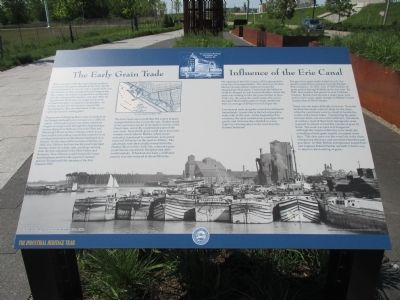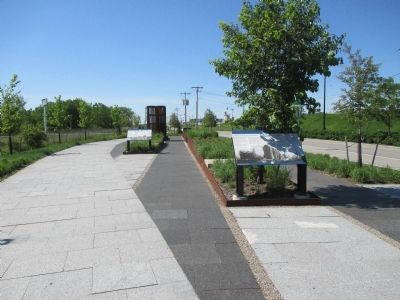First Ward in Buffalo in Erie County, New York — The American Northeast (Mid-Atlantic)
The Early Grain Trade / Influence of the Erie Canal
The Industrial Heritage Trail
Inscription.
Wheat was one of the first agricultural products planted by European colonists in the New World. In colonial times, it was not only a staple of life, but also became an item of national and foreign trade. The western movement of population accelerated after the American Revolution, and after 1800, the Appalachian Mountains no longer marked the western boundary of American civilization. As settlers moved into the terrirory beyond the Appalachians, they devoted much of this newly cultivated land to raising grain.
The process of shipping these crops to markets in the Eastern Seaboard and overseas was a difficult ordeal. Midwestern grain was either carried by wagon on rough raods through the Appalachians, or was shipped on flatboats down the Ohio and Mississippi Rivers to New Orleans, where it was then loaded onto sailing vessels that carried it to its eventual destination on the Eastern Seaboard or in Europe. By the time of the Louisiana Purchase in 1803, New Orleans had become the most important trading center for wheat, corn, and flour arriving from the new farmland in the Ohio Valley and Kentucy. New Orleans would remain the major transshipment point for the export of western grain to Europe until the opening of the Erie Canal in 1825.
[map] The Erie Canal in Buffalo, 1906.
The Erie Canal soon would alter the course of grain transported from the west to the east. Buffalo stood at the easternmost point of navigation on four of the Great Lakes, and at the westernmost point of the new canal. Henceforth, grain could move across the western Great Lakes to Buffalo, where it was unloaded, transferred to canal boats, and carried westward 363 miles via the canal to Albany. The canal boats were then usually towed down the Hudson River to New York City, where the grain could then be exported to European and other world markets. What had once been a 3,000 mile journey was now reduced to about 500 miles.
The opening of the Erie Canal in 1825 represented a revolution in transportation. The canal was the first efficient transportation system to breach the Appalachian Mountains. Grain from the Midwest could be shipped by lake boats to Buffalo, where the canal was waiting to take the grain further to New York City. By using the canal system, the cost to transport Midwestern grain to reach market fell from an average of $70 per ton to $10 per ton.
Commercial trade along the canal did not flourish immediately, in part due to the lack of people to trade with in the west. At the beginning of its existence, the canal carried more passengers than goods, and it became the vital link in a new highway of immigration to the west from the Eastern Seaboard.
The growth in grain trade started slowly, but quickly expanded as demand from the Eastern Seaboard grew. In 1831, only 173,000 bushels of grain passed through Buffalo on its way east. By 1841, that number had grown to over 2 million bushels. Buffalo had become a major grain port, and in a few years, grain receipts in Buffalo would surpass that of New Orleans.
There was one major difficulty, however. Even the smallest lake boats were too large for the canal, while the canal boats were too small to handle the waters of the Great Lakes. Transferring the grain between boats was slow and inefficient. Hundreds of workers, most of them Irish immigrants, were required to unload or load this volume of grain by hand. The work was hard and dangerous. Although the vessels of that day were small, the unloading of bulk grain usually consumed many days. This slow pace was the weak link in the chain of improved efficiency and movement that the canal provided. In 1842, Buffalo entrepreneur Joseph Dart and engineer Robert Dunbar set forth to find a way to improve handling of grain.
Canal Boats on Buffalo's Inner Harbor, circa 1900. Image Source: Library of Congress, Detroit Publishing Company Collection.
Erected by The Industrial Heritage Committee, Inc.
Topics and series. This historical marker is listed in these topic lists: Agriculture • Industry & Commerce • Waterways & Vessels. In addition, it is included in the Erie Canal series list. A significant historical year for this entry is 1825.
Location. 42° 51.492′ N, 78° 52.202′ W. Marker is in Buffalo, New York, in Erie County. It is in the First Ward. Marker is on Fuhrmann Boulevard, ¼ mile south of The Skyway (New York State Route 5), on the left when traveling north. Touch for map. Marker is in this post office area: Buffalo NY 14203, United States of America. Touch for directions.
Other nearby markers. At least 8 other markers are within walking distance of this marker. Fireproof Grain Elevators / Concrete Grain Elevators (a few steps from this marker); The First Grain Elevator / Early Grain Elevators (within shouting distance of this marker); The Grain Industry Decline / Buffalo's Grain Legacy (within shouting distance of this marker); The Grain Elevators (about 300 feet away, measured in a direct line); The Engineers of the Grain Elevators (about 300 feet away); The Standard Elevator (about 700 feet away); The Wheeler / GLF Elevator (about 700 feet away); The Spencer Kellogg Elevator (about 700 feet away). Touch for a list and map of all markers in Buffalo.
Credits. This page was last revised on February 16, 2023. It was originally submitted on July 15, 2015, by Anton Schwarzmueller of Wilson, New York. This page has been viewed 462 times since then and 45 times this year. Photos: 1, 2. submitted on July 15, 2015, by Anton Schwarzmueller of Wilson, New York.

